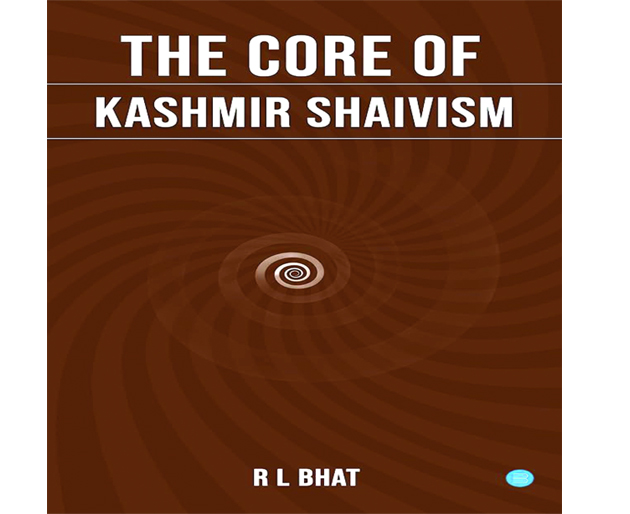Pradeep Kaul Khodballi
The core of Kashmir Shaivism
Dr R L Bhat, well known author and social activist has many books to his credit. He has written copiously on different subjects like linguistics, literary criticism, history, politics and philosophy. The author has arrested attention of scholars and lay public alike, with his vast swathe of writing that is bound to earn him an enduring place in the consciousness of general public and scholars.
This book from the author is unique in many ways. As he writes in his introduction, that this work is the result of a long association with a unique Master of Kashmir Shaivism Vish Nath Bhat Jyotshi. Vishnath Bhat taught many students, the esoteric philosophy emanating from the serene spot of Kashmir. The author along with many of his co students learnt the salient features of this particular philosophical system under his hallowed tutelage. The author has dedicated this book to his teacher which in line with the Indian tradition of a receptive and grateful student dedicating his book to his teacher.
The author in a frank statement delineates this information which reflects his candid mind.
The Core of Kashmir Shaivism is actually a translation of two of the seminal works on the philosophical system of Kashmir Shaivism, one Parapraveshika and the other Pratybhijna Hrdayam both composed by eleventh century philosopher and scholar named Ksheemaraaj.
Ksheemaraaj is the famous student of the great eleventh century philosopher and peerless master of Tantra, Sri Abhinavgupta, who flourished in Kashmir probably between 945 to 1020ACE. The author has translated nearly verbatim what he learnt from his teacher Sri Jyotshi Ji.
Pratibyjina Hradyam an important work on Pratybhijna philosophy perfected in Kashmir during a span of three centuries. This system called theory of Recognition has arrested attention of scholars world-wide due to its rational logical foundation. But due to the ravages of time and virtual oblivion this philosophical doctrine could not reach the people in a seamless flow.
Dr Bhat, traces the genesis of the Trika or Kashmir Shaiva doctrine from Rsi Durvasa to Amardaka Naath, Srikanth Nath and Trymbaknaath, Vasugupta, Bhatta Kallat, Somananda, Utpalaldeva and then to redoubtable Sri Abhinavgupta, Kshemraaja etc. The author also touches upon the various branches of Shaiva doctrine like Kaula, Krama and Spanda. Dr Bhat recalls the great contributions of Nineteenth century saint Swami Raam who received direct instruction in the Shaiva or Trika doctrine from Siddha masters. He would take regular classes and teach to students in downtown Srinagar city where he resided. Thus, in a way the modern time resurrection of this wonderful philosophy of India can be attributed to Swami Raam. To a reader, outside the Union territory of Jammu and Kashmir such information is necessary for the creation of a cursory historical background and perspective.
The first chapter of the book on Parapraveshika is a beginner’s guide to enter this philosophical system. The chapter traces the nature of the world, its transitoriness, the elements that this world is made up of and the nature of the essence of the Absolute. The author has in a simple way touched upon this very fundamental property or category when he discusses the Absolute as BiiJ Hradya. May be, this is the quintessence of His essence that the author points to, none the less interesting.
The second chapter of the book discusses the salient features of the System of Recognition called Pratybijnya. Kshemraaj in his introductory statement in this work emphatically states that this book is meant for those who are not well versed in the intracacies of logic, debate and philosophical insight, to quote him…
Ieh yeh sukumaar matiyoakrit teekshn tarkshaastra parishrama shaktopaat unmishit paarmeeswar samaveesh prabilashina kaschit bhakti baajah teshyaam ishwarpratibijnyo updesh tatvam manakunmilayate..
“This work is meant for those who have the cognition of a child and are not initiated into the intricacies of the doctrine of the logic. But still, they have a desire to know and delve deeper into the system and merge with the Absolute. For them only this work namely Pratibijnya Hradyam is being composed.”
The book contains translations of difficult words into simple English making it understandable to all. In his introduction the author has given a conceptual framework of world, its genesis through the descent of Shiva via the gradual constriction of his supreme awareness till the final element of Bhumi. All the 36 elements of the doctrine have been disused. The five acts of the Absolute Viz. Sristi, Sithiti, laya, Pidhaan and Anugrah are discussed in good detail.
In the second chapte,r essential features of Recognition doctrine like, Prakaash and Vimarsh are discussed. Here, these terms are core of Kashmir Shaivism because they delineate the essential nature of Shiva as Light and Awareness of that Light. To the beginner, this chapter in simple form and language discuss the nature of world, nature of freedom and methods through which the true nature of the Absolute is comprehended. Another term that the author discusses here is Vikalp Kshya, the destruction of thought constructs. This spiritual process behind this term is central in attaining the immersion with the Absolute.
For a welcome change, this book though small in size is yet big in Idea. It gives to the beginner the feel of difference between Advaita Vedaanta of Sri Sankara and Kashmir Trika doctrine. In some footnotes like on page 68 a comparison between Indian monistic thought and semitic monotheism is given. To the discerning reader it becomes crystal clear that how semitic ‘attempted’ monotheism stands nowhere near the comprehensive scheme and system of Advaita or Recognition doctrine.
In the appendix of the book the Sanskrit text of both works, Parapraveshika and Pratibijnya Hradayam is given. The texts make the book a complete beginner’s guide for aspirants who wish to swim in the cool and tranquil waters of Pratibijnya doctrine of Kashmir Trika philosophy. A must read for all who are interested in India and its timeless philosophy.
Trending Now
E-Paper


